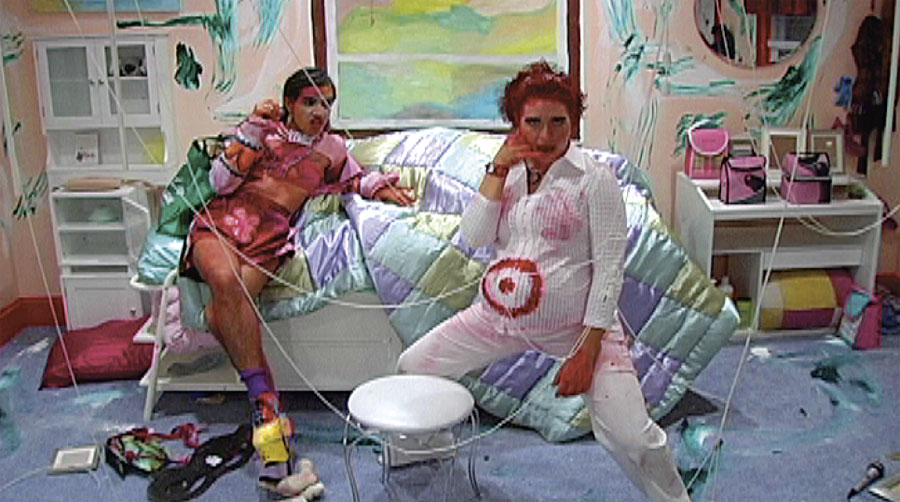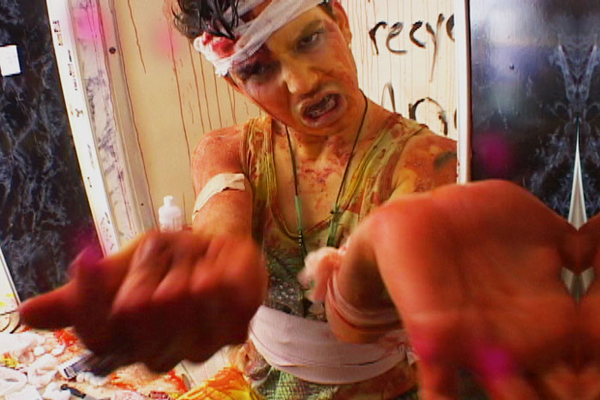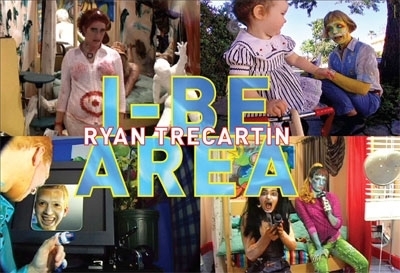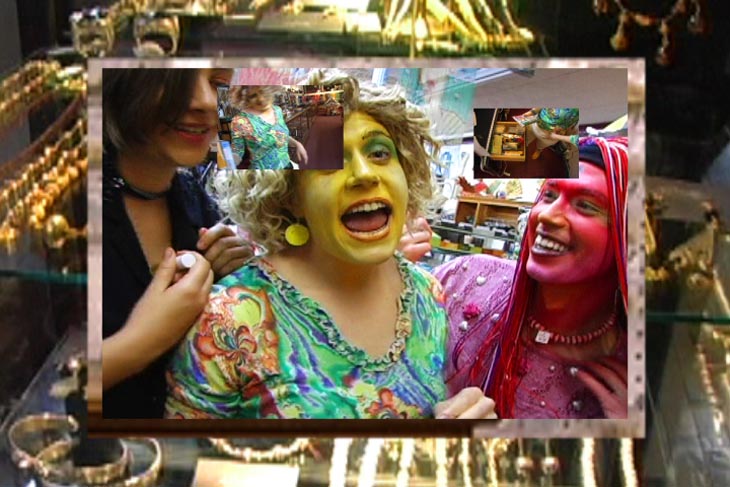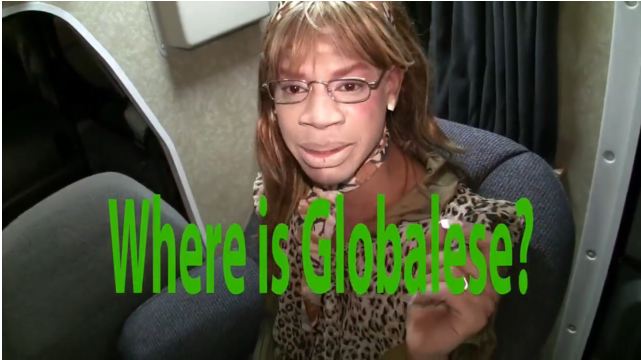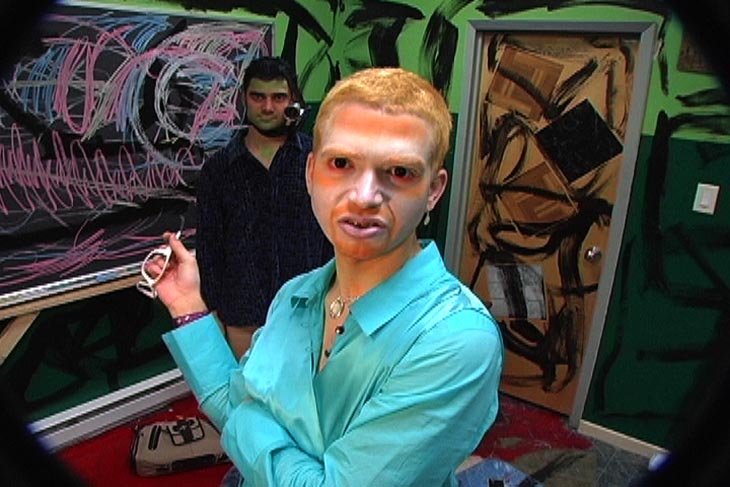
An interview with Ryan Trecartin, San Francisco Bay Guardian, January 2008
Video Mutants: Ryan Trecartin streams/flows into onlive timeslot, TOtal nowhere emotion expansion
SF Bay Guardian: In I-Be Area, the Wood Shop is like the most nightmarish gay dance club I’ve never been to. I dream about it a lot. How did you put together the Wood Shop scenes?
Ryan Trecartin: It was a three shoot workout, in a space called The Woodshop Drama Room one of three rooms that make up Jamie’s Area which is a conceptual part-Cyber-hybrid Platform that obeys and functions with in both laws of Physics and virtual-non-linear reality and potential in Web 2.0/ultra-wiki communication malfunction liberation flow, add-on, and debate presentation. The main structure is the character Jamie her self- a total control damage freak with independent log-ins, muse extension people, and live-links. The Wood Shop is a situation stage where pho-male-cyber-gays login to over posted anti-productive decisive message board dead-end faggoting activities. Jamie has a composer status in this scene during another timeslot using her saw and wood dictating with wireless momentum control and influence over her haters at work, while mirroring in Dark Jam Band form, on cell-phone with Ramada Omar in Class Room separated by a closed Window (3 time slots being viewed). The Wood Shop Fags search-out wanting a free channel edge and perform a permanent Window opening on Ramada Omar Freeing it to an independent Multi-tasking shape shifting reality pool. The actual shoot was really fun. It had a script but was the most abstract shoot of the whole movie-lots of improvisations and an everyone talked at the same time, making a don’t be quiet on the set situation. Like planed home video- script-destruction theme over goal. My favorite part is when Solomon (black hair pig-tale mall goth wig) has a brick ready for the Break Down, in cell phone placement and says nothing about someone calling him on his phone an “Said”, over and over like it’s a presidential victory speech with supporters and reason promoting a total nowhere emotion expansion with self eating content, saying… what?—don’t use hotmale log out to log In father fucker.
SFBG: To me, A Family Finds Entertainment is the best hallucinatory gloss on getting ready for a night out, and actually going out, ever to be put on film. Do you go out a lot?
Ryan Trecartin: I’m seriously affected by the experiences I have at night. But I actually don’t go out that much in the nightlife way. Things that inspire me the most in nightlife situations are room vibe, agenda spinning, and communication issues. Like how people try to present what they want to show, to experience what they need to feel and act on their contrived or un-expected gut impulses. I love it and I’m not above it.
SFBG: Many of the scenes in your videos seem to be constructed like songs, with calls and responses, bridges, back-up vocals, and repetitions — and often ending with choruses and even fadeouts. You also deliciously send up the inanities of pop music in a lot of what you do, and in Tommy Chat Just Emailed Me there’s explicit references to poetry and song. I wonder if when you’re editing your videos you have specific song structures in mind, or if you see each scene as a kind of song?
Ryan Trecartin: Yes,I’m completely driven by audio – hearing the flow and intuition of music structures around people probably excites me more than anything. A good song is always needed. Music kind of explains reality in a way that actually makes sense – it’s crazy. I want to make Scenes that feel like they broke out in a total Music when they didn’t. I think of direction, script, body language, word delivery, set, edit, color, prop, and structure in a kinetic, musical, poetic way—each scene specific to itself and organized with different intentions to flow Ideas. I like when people feel it, but can’t explain it. I totally see my movies as part Musical hybrid, and the dialog works like Poetry—You sit with it, it’s layered in meaning Best to experience more than once cause it shifts in question and reveals hidden parts and connections.
SFBG: I-BE Area is an awesome fuck you to whatever Web 2.0. The sense I take away is that the demands of virtual community lead to hysteria, that so many virtual selves dissolve the original self into a stream of projected quasi-emotions and non-sequitors. Can you maybe talk about your view of technology and the self? Is there any beauty in being lost in a hall of warped mirrors, or is it all baseless horror?
Ryan Trecartin: Totally Everything, I think Technology is helping us see that “sides” and “opposites” are simple boring easy ways out of evolution—I-BE Area is kind of the questions I have right now to this question. We’re creating and participating in a new natural that we know nothing about yet. It’s like discovering fire and aliens at the same time – and not knowing it- I like living and creating in a time of overwhelming transition—I don’t want to believe in answers right now to abstract questions, because they’re always wrong somewhere else.
SFBG: Even though your videos throw all of identity into play, you’ve created some great characters. Me and my friends are obsessed with Pasta, Shinn, Wendy M-Peggy, MayFlyFLowna, and Amerisha (and we have a whole mythology created around the Bead Store and the Head-PArent). Do your characters spring from you and your collaborators organically, or do you create them beforehand intentionally?
Ryan Trecartin: They do. I write the scripts ahead of time and have a very clear agenda going into a shoot but I think of the people in my life and what they can/will/or want to do. Some people love to act, others love performing, and some people can only be themselves filtered and re-presented, covered, or over stated in an organized action—I direct in real time while performing and shooting everything in list form– hot potato camera style to create a real-time experience vibe along side of fulfilling the script. The energy starts piling and the performers add tremendously by collaborating on costumes, mentalities, vibes, makeup, even extra sections and props. They twist up the lines by saying what they think I told them to or what they want instead of what I want—It gets really open but starts ultra organized and ends in Hyper organized re-evaluated through editing structure and spinning—editing can feel manipulative and creepy—The shoots can sometimes feel more crazy and out of control fun/damaging than the presented results or the other way around.
SFBG: What are you up to by way of current or future projects?
Ryan Trecartin: I’m writing a script for a trilogy in three different presentation formats-And looking for more performers= Add: Creative people of any age—If you can sing or dance or something and like performing please write me on my youtube account. http://www.youtube.com/profile?user=WianTreetin.
Ryan Trecartin interview with Jennifer Lange (Wexner Centre Associate Curator) May 2008
Jennifer: I-Be Area is so dense, visually and as a narrative. In less than two hours you manage to construct a story using a huge cast that touches on everything from cloning to virtual identities to life in a mediated world. You also make just as many and as varied visual references. What’s the starting point? Is it one idea that leads to another or is there this grand vision that you set out to realize?
Ryan: For I-Be Area —I didn’t have the title until the very end—I started the project thinking about the structure of areas and space, both virtual and physical, and how the logics of each inform the other in tension and how ideas of territory change as the idea of space, nature, realness, and time change in a post-industrial, pre-complete technologically integrated world. The first brainstorm for the movie was in celebrating the messy transition of an accelerated crash into a world nature 2.0 that jumps into use before we have the time to ease into it with no culture space to form general understandings of new collective manners and appropriateness or codes of conduct. I love the idea of technology and culture moving faster than the understanding of those mediums by people. It’s like the jumper being jumped before the onset of “jump”—and the whole world is doing that, like tradition out and unmarketable.
I use topics that are universally personal and, so far, I think, timeless to the human race such as family, identity, pregnancy, sexuality, business, money, ownership, trading, sharing, eating, dieting, friendship, back-stabbing,…and then I use them as tools to parallel and describe more in the moment and temporary attitudes and mentalities of transitions in cultural momentum today. I think I do a lot of translating vibes into visually narrative time sculptures that story shuffle questions into abstract plots of now.
It’s kind of like taking peripheral vision and focusing the whole thing while allowing pieces of content to fit with in the expression of idea and momentum through a narrative jump-around. With characters more as vehicles in the presentation of ideas and not as entrapped one-road storytellers with character-driven motivation.
The process starts with themes and agendas/goals, mentalities, expressions, costume ideas, transition feelings, set thoughts—I make lists. At the same time I start work on dialogue in an everything-goes, brainstorm-type way—the brainstorm may start with a place or topic. They start to inform each other—the list turns synthesis with segments of dialogue and I start to pull out scripts and revisit ideas of theme and structure. I start to focus in on the parts that when reread inspire new rants and tangents that shape some sort of an excitement to create workflow. I think about music. Eventually I’ll have a collection of scripts and I start to figure out how they connect and begin to pull characters out and define them more. I melt down numerous characters, lists, or ideas into one character or set ideas or separate themes and goals into places and costumes or sections of multiple character tension. At this point I start to have momentum and the conceptual aspects of the piece solidify and it becomes easier to write because the sections of vision now have pile. All the while I’m considering people I know who inspire me and who I respect greatly, and what or who can do you or that or them and how who can do what in what situation, and combinations of ideas, people, sets, characters start to inspire the quality of scene ideas—how does this person clash with that character or set to play what—it’s like organizing a setting to yield a quality behind the camera that informs the script, directing, set, costume, makeup, and general vibe of the shoot that night and then I go for it with a couple shots—I then build out the story—but I allow my self loopholes and extra shots and free space—I change the meaning of shots by shooting other shots. I fix a failed shot by changing what the shot was about while adding to plot or slicing into new content. The shoots are very active and the directing style is very kinetic and even when we stick to the script in a strict sense the room still becomes very collaborative and people take ownership of their characters and perform outside-of-themselves rather than act. Usually—I mean some people like to perform, others like to act, and some just want to be themselves but louder in a chosen style or imposed accent, accents being less geographic and more collected and sculpted to describe word delivery. And then once with the footage I reevaluate everything as supplies. And then I dive into EditEffect and sound as content and resculpt the whole situation—more than half the script gets cut out and many moments of people giving a burst of inspiration, improv, or add-ons get cut in.
Jennifer: Collaboration is a big part of your practice in both your sculpture and installation work as well as in your videos—family, friends, former classmates, and fellow artists all appear in some form or another in your work. Can you talk a little about their contributions? When you’re writing a script, do you have certain people in mind to play characters?
Ryan: Every single form of collaboration possible happens—from assignment-based to organized-event- set-up-and- shoot to straight-up equal parts (I equal part with artist Lizzie Fitch a lot). The people I work with are all creators and makers in a wide range of arts. They’re people that inspire me to make—I make these movies for them, and friends. It really is a community effort, I think the word network is usually used in a business-type way—but friends really do network nowdays and make a point to meet friends of friends of friends and it becomes a community web of share and tell.
Jennifer: How much do you encourage improvisation?
Ryan: I use a script—but everything gets tossed out the window during each line. When we stick to the script the shoots can be very long and hard all-nighters. Sometimes we go on rants that take hours in the moment, idea-sculpting like a brainstorm, and the shoot becomes more like a party or we become an actual brain. People really give a lot! But we always come back to the script just in case. I make the script happen for an editing backbone—everything depends on the themes and content—on first view it may seem like my movies are random bits of chaotic poetry. And there’s truth to the last half of that sentence, but none of it is random, there is a real story. People in general like the structure of a script, it allows for more improvisation in places that are freeing and experimental like body language and prop use or attitude and pose. I shot things in script order, it’s really hot-potato-camera-kinetic, you-go, you-go, you-go shooting. No one reads their part ahead of time; it’s very pile-on. People build their character based on what they said last and how we’re yelling or telling at each other—the room vibe gets made and things play out like my turn with minimal descriptive set-up to encourage chemistry and ownership. It’s like, “run over there, say this, and you’re sad to her right now. And then do it 10 more times with your arms doing this and your head angled like how you feel.” I think the most important aspects of the videos are the script, casting, performance, and scene-shooting style. Most people think of the visuals but that is all used, along with editing as content—to enhance the delivery of areas and moments.
Jennifer: Your collaborators more often than not are your former classmates from the Rhode Island School of Design (RISD). Clearly you all are passionate about each other’s work and inspire each other deeply. I know you’ve been asked this before but do you think there’s something specific about RISD that engenders a certain aesthetic/way of working, or do you think of it as pure serendipity that you found each other?
Ryan: Well, I no longer find myself in a total RISD bubble and I’ve met many people since school that I’m completely blown away by. I think RISD has a unique set up that encourages community, out of the art world eye, and so for undergrads there is an amazing sense of total freedom and optimism, with absolutely no ugly competitive anxiety. It’s a big small town art bubble with no make-or-die pressures so everyone is left sharing and adding to each other as people and makers while teaching and experimenting in each other’s visual languages. But a school is just a meeting place—four years doesn’t make a person, serendipity happens, and then RISD happens to be a perfect set up for young, naïve, right-out-of-high-school weirdos to ferment before learning about the world. I do find a bond with almost anyone who has gone there, because RISD seems to bond people more than most art schools and encourage group efforts and extreme focus on multiple things and drive. Seven of my best friends I met freshman year. I think when you meet people that young you collectively make a logic for being critical and hating on things—but you still have individuality in what you love on—so as time goes on you find yourself in very challenging company because they know how your brain works and you know theirs—like blood sisters and teamwork, take it to the group and have it thrown back at you way better.
Jennifer: Despite being included in the Whitney Biennial and galleries and film festivals around the world, you’ve put both I-Be Area and an earlier work, A Family Finds Entertainment (AFFE), on YouTube. Why is this channel so important for you?
Ryan: I have very strong feelings about sharing. I make videos for people—the whole process is shared. I’m always seeing the videos in multiple settings and the places for viewing that excite me the most are home entertainment systems: private computers and theaters. I think web 2.0 spaces relate tremendously to the logic and structures of physical space and plot sculpting in the movies. So I think it’s an appropriate home that brings out a quality in the work that you may look over in the gallery. Plus videos are meant to be accessed and watched.
Jennifer: I think it’s interesting that you can watch I-Be Area out of sequence and, in fact, that’s the only way to watch it on YouTube. It’s a totally different experience and yet, somehow, there’s still this narrative to follow. Do you structure the script with this in mind?
Ryan: I naturally structure scripts this way—I think it may be generational. It’s how I link and flow-out in presentation. Software and Internet platforms feel really natural and intuitive once the tools are understood. I think the brain reacts very naturally to technology that frees it from linear structures of physical space-making. The narrative in sectionalized transitions that contain and then open up is just how I think. In a world where it’s more insane to choose something since everything can be everything or had—slapping up sides and focusing on choice is outrageous and I think those sides create shiftable, episodic sections that work well in a shuffle or a multitasking chunk. It’s more like a conceptual given. People split movies up all the time now and choose their favorite 10 mins., reedit, reshow, reorganize. I’m pre-apart of that world so it kind of has an inherent set up in my post production intentions. I ultimately enjoy the movie in order—cause the flow of transition and order add narrative content that is intentional. With some of the earlier work like AFFE 2004 people talked about how weird, post-camp, and new the acting felt and how the mentality was on Off and On at the same time, unsarcastic and what? Why are these kids acting like this? And back then it was just it—we didn’t even have the Internet in our house. But technology flows with the momentum of culture, our generation was ready for something like YouTube cause we already had it in our logic and in 2005 when it came out—I think it totally changed how people think about the ways in which people act in my movies, like new technologies create different qualities in understanding and presenting ourselves performatively. We’ve come a long way since back when dating online was considered dangerous, gross, and perverted.
Jennifer: Do you read all the comments posted about your work on You Tube?
Ryan: Yes, I love when people surf out on a message boarding frenzy.
Jennifer: What’s the next project?
Ryan: I’m still in the making lists part.
Ryan Trecartin: Data Purge by Jon Davies (April 2010)
The young American artist Ryan Trecartin’s vertiginous performance, media and installation practice seeks to give physical form to the abstractions that govern life in the digital age. The structures and motifs of globalized, networked media and communications become characters, narratives and environments in his work. Cyberculture is rewired through the fallible human body, with all its entropic, expressive energies and potential for physical and communicative breakdown. The result is a messy and excessive sensory bombardment that scrambles his viewers’ processors and rewires their comprehension of cinematic storytelling, time and space. Consequently, Trecartin’s work has commanded the art world’s attention in a matter of a few short years.
Trecartin was born in 1981 in Webster, Texas, and raised in rural Ohio. He attended the Rhode Island School of Design, where he studied video and animation, receiving his BFA in 2004. Relatively cheap to live in, packed with art students and close (but not too close) to New York, the city of Providence is known for being a hotbed of discipline-crossing DIY experimentation in terms of culture and community. It was here that Trecartin found his crew of like-minded creators, dubbed the XPPL (Experimental People Band). Upon graduation, Trecartin and friends decamped for New Orleans and then, following Hurricane Katrina, he has lived itinerantly, working in Philadelphia, Miami and Los Angeles, among other locations.
Trecartin captures the addled mental state of a generation raised by the Internet and the glut of information (though not necessarily knowledge) that it offers access to. Through his queer hysterics/theatrics and the hallucinatory digital manipulation of every image, object, space, and sound on-screen, Trecartin’s work is a seething stew of the bodily, the discursive and the virtual. He transforms the space of the screen into that of the computer desktop with hundreds of windows open, each addressing you with a character high on what writer Wayne Koestenbaum has succinctly called “connectivity” and “morphability”.
With seemingly no history to speak of, Trecartin’s attention-seeking characters spout a painfully ‘contemporary’ dialogue composed of pop-culture references, trendy buzz-words, harebrained theories, talk-show confessions, and text-message shorthand. This sub-cultural meta-language might sound nonsensical at first, but on closer inspection it reveals itself as a witty and incisive (if absurdly circuitous) diatribe. Working in an improvisational performance tradition with mostly non-professional actors, friends and acquaintances of all ages, genders and races, Trecartin writes a script but lets his performers play within it.
The characters’ rapid-fire sentences (or fragments thereof) are more often than not punctuated with an act of physical destruction: Bodies plunge through walls, smash picture frames (or bed frames) or swing sledgehammers through windows. This violent body language amplifies each spoken word through seemingly nihilistic gestures, but only IKEA furniture ever breaks, not human beings. Trecartin’s mash-up of a script is frequently delivered in an exaggerated, neo–Valley Girl tone distilled from the likes of Paris Hilton and Britney Spears. Similarly, the cadences and beats of their frenetic speech—and the pauses for breath and accentuation in between—are dislodged from rhetorical logic. This inhuman, synthetic-sounding organization of verbal language is further intensified by Trecartin’s digital manipulation of many of the voices and statements in post-production. The most punchy Trecartin sequences—the ones that really stick—use montage to create rhythm and something approaching sense from his mind-melting flow of audio-visual content.
Trecartin has maintained a fascination with cloning and the multiplication of identity throughout his multifarious projects, from the cracked coming-out story A Family Finds Entertainment (2004) to his suite of seven videos—the interconnected trilogy K-CoreaINC.K (Section A), Sibling Topics (Section A) and P.opular S.ky (section ish) (all 2009), and the four-part series Re’Search Wait’S (2010)—all showing together for the first time in The Power Plant exhibition ‘Any Ever’. This theme spans the increasingly overlapping realms of biology and the digital, just as the successful cloning of ever more complex and sentient mammals parallels the culture of self-replication fostered by social media. YouTube, for example, provides a hotbed for the generation of an infinite number of performances of the self, with even the most bare-bones confessional video blog inevitably constructed in dialogue with the dizzying archive of moving-image material to be found on the site. (And of course, each of these posted videos becomes the material for an infinite number of remixes and remakes, homages and perversions authored by millions of savvy autodidact editors.) Facebook for its part has honed the careful cultivation of one’s public image into a digital art form, though again always in dialogue and in tension with other users and their whims (you can un-tag yourself from an embarrassing drunken photo, for example, but you can’t delete it). The figure of the avatar in gaming, meanwhile, is so familiar in popular culture as to have lent its name to the colossal entertainment product that is James Cameron’s 3D, CGI film Avatar (2009).
Such a bloated corporate enterprise as Cameron’s seems to be from an entirely different planet than the grainy pixelation of the online video realm where Trecartin’s work has found a popular audience outside of the art world. Instead, Trecartin’s spectacle is a kind of DIY sci-fi: the future will be experienced through multiple web browsers and home editing-suite filters. I-Be Area (2007) remains perhaps the purest and most deserving of the term ‘epic’ among Trecartin’s cinematic concoctions, with its dual protagonists of I-Be 1 and her clone I-Be 2 and its preoccupations with adoption and other non-biological forms of connection and reproduction. Trecartin’s characters are digital data and they know it. Subject to being designed, rendered and transmitted like files, they can fluidly shift identity, form and affect at the press of a button—not to mention falling out of ‘acting’ and into ‘being’ at the drop of a hat. This ostensibly liberating power of pure mutability carries a dark undercurrent, with everyone screaming over each other to be heard, and no stable home or selfhood. These concerns with family and biology are resurrected in Sibling Topics (Section A), which begins with a character named Carryon Ova—who boasts a digitally-distended, constantly mutating pregnant belly—addressing her quadruplet daughters Ceader, Britt, Adobe, and Deno (all played by Trecartin, all of their subjectivities blurred).
K-Corea INC. K (Section A) finds Trecartin portraying just one of dozens of near-identical ‘K-Coreas’ from all over the world attending an endless company meeting. Each is identifiable primarily by their mock-ethnic accent since they share the same blonde wig, glasses and business-casual women’s wear (all part and parcel of their collectively performed whiteness and womanhood, which Trecartin calls “work-face”). Their Sarah Palinesque style and hyperbolic pronouncements, mass-produced to become a kind of uniform for the jet-setting businesswoman of today, takes on added menace with the quip: “rethinking the word humanity as an object with a goal.” Here Trecartin finds a delirious corporeal form for the unfettered global traffic of capitalism: each is an “offshore identity storage unit”—certainly nothing more human than that—enacting a hyped-up version of the corporate bump and grind and always at risk of being made redundant by their formidable lady-boss, Global Korea. A climactic sequence features an airplane full of the Koreas screeching and getting drunk, eventually setting a stewardess—who resembles more of a Leigh Bowery creation than Karen Black in Airplane—on fire. (The airplane is an anachronism: none of these characters actually require hulking masses of steel to travel through space and time, just willpower.) The fuselage set we see is a homemade construct installed in someone’s house, with the ‘real’ outside world visible through the back windows—nothing is seamless.
It is important to point out here that Trecartin always works collaboratively—most commitedly and from the very beginning with Lizzie Fitch—and returns with the same troupe of performers from one project to the next, though each is inevitably expanded with people met or found along the way. His projects register this ad hoc community’s impulses towards both creation and destruction, as characters, sculptures, paintings, and architectures are built up only to be destroyed in the cathartic, even orgiastic ritual that is the shooting process. (Arguably this libidinal dimension casts the equally energy-consuming but solitary work of editing—an intensive, monomaniacal process that Trecartin claims is fuelled by junky microwave meals—as a masturbatory one.)
While much ink has been devoted to Trecartin and his work, very few critics have described his non-linear experimental narratives in detail, unless quoting directly from the artist. The speed and simultaneity of the plot threads, sudden transformations of the characters, fluidity of time and space, and shrill mode of delivery make the narrative structures confusingly rhizomatic and abstruse, tough to take a step back from and summarize beyond the subjective pleasure and terror-filled experience of them. This intense degree of abstraction mirrors the impossible-to-grasp paroxysms in the global economy—particularly the recent ‘crunch’ that seemed like it might doom us all to eating foraged twigs and berries—and the increased immateriality of credit and of finance. Increasingly difficult to comprehend too are the changes to our genetics as technologies become more and more intricate and the once-unimaginable becomes real. Digital video—amplified through animation/CGI technologies—is in a unique position to similarly make the imaginary tangible and manifest: what physical bodies won’t do, pixel-tweaking can.
However, it is remarkable just what these bodies can do, particularly Trecartin’s athletic shape-shifting, which has seen him transform into dozens of distinct characters through costumes and make-up, not to mention tanning: Shin, Amerisha, Pasta—their names part Warhol superstar, part Walmart. While the models of identity proposed in Trecartin’s videos feel radically new, they fall into the legacy of queer underground film and performance of figures like Jack Smith and John Waters (frequently name-checked in writing on Trecartin) who advocated perverse dress-up, striking an exaggerated pose and rabid acting-out as flaming forms of self-fashioning and self-projection. In ‘Any Ever’, the possibility for imaginative identity construction is also opened up for viewers: As people walk through the labyrinth of distinct ‘containers’ that Trecartin will create at The Power Plant, they will be confronted with non-sequential, open-ended and polyphonic cinematic realities that, in Trecartin’s mind, are to be ‘edited’ by viewers into some semblance of cohesion depending on where and how they direct their attention. Each of these framing environments will take on another form—board room, airplane, etc.—echoing how the settings and spaces in the videos themselves are of decidedly unstable materiality, constantly shifting in terms of what worlds they enclose—and what possibilities they present.
Jon Davies is a widely published writer, particularly on film and video, the co-curator of the exhibition ‘Ryan Trecartin: Any Ever’ with Senior Curator of Programs Helena Reckitt, and the Assistant Curator of Public Programs at The Power Plant.
